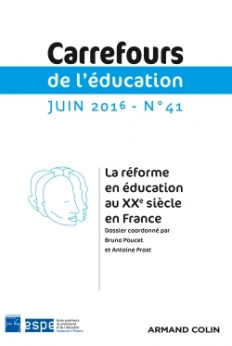
Carrefours de l'éducation n° 41 (1/2016)
Pour acheter ce numéro, contactez-nous
Recevez les numéros de l'année en cours et accédez à l'intégralité des articles en ligne.
Engagée pour améliorer son efficience et la rapprocher davantage du monde du travail, la rénovation de la voie professionnelle lancée fin 2007 propose en fait une nouvelle architecture des diplômes et de l’offre de formation. Outre qu’elle généralise la préparation du baccalauréat professionnel en 3 ans, elle fait du BEP une « certification intermédiaire » sans formation et relance le CA P dans les lycées professionnels. En dépit des arguments liés aux besoins économiques et professionnels officiellement brandis, l’analyse de sa genèse et de ses premiers résultats montre que ses objectifs sont plutôt budgétaires et scolaires, le travail et l’emploi occupant une place très secondaire. Elle s’inscrit par conséquent dans une politique de scolarisation de la voie professionnelle, qui contribue à brouiller l’image des diplômes dans le système éducatif comme sur le marché du travail.
Launched in 2007 order to improve vocational training’s efficacy and bring it closer to the working world, the renovation of vocational studies actually consists in a new structure for the diplomas and trainings on offer. As well as generalising the preparation of a vocational baccalaureate in three years, it transforms the BEP into an intermediary diploma and launches anew the CA P in all vocational high schools. Despite the official arguments, which make much economic and professional needs and requirements, the analysis of its genesis and first results indicate that its objectives are actually budgetary and school-based, work and jobs having only a very secondary importance. The reform is actually part of a politics of subordinating vocational training to the school system, which contributes to the lack of clarity of the meaning of diplomas both within the school system and on the jobs market.